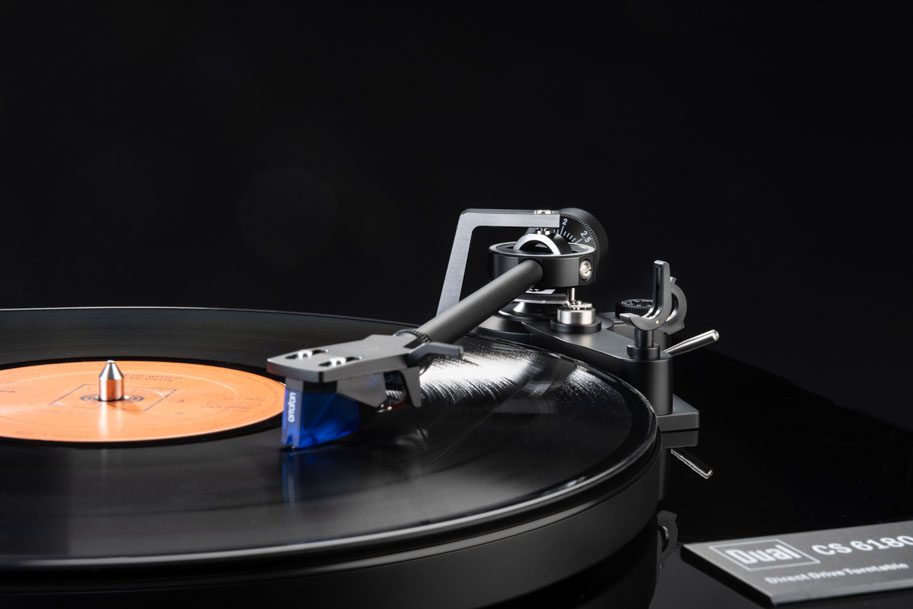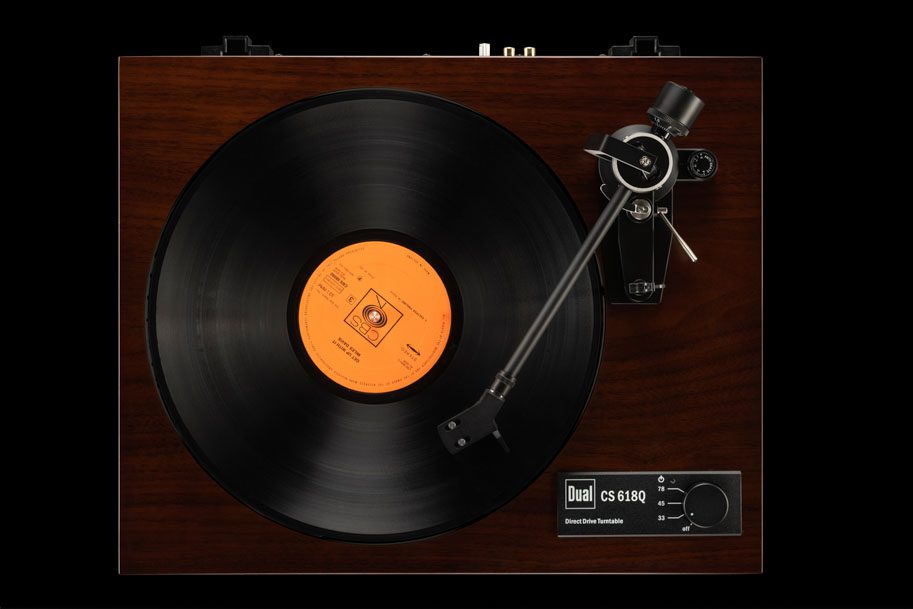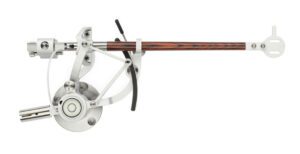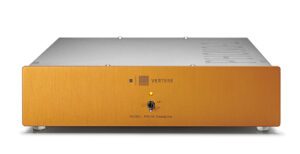
“I used to have one of those!” has been the unprompted response from three different people when I’ve mentioned that a Dual turntable was passing through for review. In a world where the overwhelming majority of contemporary audio brands have absolutely no cut through with people not invested in hi-fi, Dual seems to have an impressive degree of name recognition although, it’s worth adding that two of the three individuals concerned were surprised to learn that Dual still exists.
In fact, the company produces a range of turntables that are all relatively affordable and includes some with fully automatic operation which is a rare thing to find in 2023. The majority of these models are belt drive designs but the CS-618Q you see here and the flagship Primus Maximus switch over to direct drive for platter rotation.
Coreless inductors
The motor responsible is a quartz stabilised device with coreless inductors and double shielded Rotormagnets to eliminate any stray magnetic fields. Compared to the unit in the similarly priced Technics SL1500C, it doesn’t feel as hefty, an impression partly created by the Dual running on a 12v wall wart rather than having a mains input. Nevertheless, the spin up time is extremely brisk and the CS-618Q gives you the option of 33, 45 and 78rpm playback. The platter it acts on is cast aluminium and damped via 2.5mm thick rubber mat.
Directly coupled
The spindle is contained in an MDF plinth that is reasonably substantial and sits on four feet. This makes the Dual rather more directly coupled than its rivals but it shouldn’t be too hard to ensure it isn’t affected by the outside world.

The tonearm is a straight tube with detachable offset headshell. This is a rarer fitment than the combination of S or J shaped arm and straight headshell but aftermarket options do exist if you wanted to have more than one cartridge on the go. There will be some limits to what works on the arm as VTA is fixed but the bulk of cartridges under £500 should be fine as they are reasonably similar in height and both tracking force and antiskate can be simply and accurately adjusted. Dual equips the CS-618Q with an internal moving magnet phono stage but, should you wish to experiment with moving coil you can bypass it via rear panel switch. A welcome touch is the fitment of a pair of RCA outputs and a ground connection on the rear panel, rather than simply relying on a captive lead.
As standard, the Dual is fitted with an Ortofon 2M Blue cartridge, which is a solid choice for this sort of application. The Blue is subjectively my favourite of the 2M range as I’ve found it a little more forgiving than its more sophisticated and expensive stablemates. The Technics, by way of comparison, uses the cheaper – and to my mind inferior – 2M Red. Something else that is potentially useful is that there is a 78rpm model in the range too which could be affixed to another offset headshell and swapped in and out fairly easily if you wanted to.
Supplied in the gloss black option (a walnut and ‘black ash’ style veneer is also available), the Dual goes a decent way to feeling worth the asking price. The build is extremely good with all the points where you are likely to come into contact with it feeling substantial and well engineered. The presence of a lid is a welcome feature too and gives the CS 618Q a degree of survivability in shared spaces that some rivals lack.
Perhaps the only curious operational quirk of the Dual is that rotating the speed control to any of the three speed settings will not actually start the platter moving. This only happens when the arm is moved across towards the record. It works fine once you’re used to it but can cause some initial head scratching when the platter doesn’t move. There is a clever and very well executed autostop/lift on the Dual; the one on the Technics sends the arm bouncing into the air.
Connected up and initially running via its own internal phono stage, the Dual delivers on the both the basics and the promise of direct drive. There’s no discernible noise at the playing surface and no evidence of cogging or any of the supposed bugbears of the system. Pitch stability seems to be excellent too. Standard tests like sustained strings and struck piano notes are all well handled.
There’s more than basic competency here though. Listening to Marc Moulin’s Placebo Years 1971–74 [MOV], an album that while largely jazz based, gives the faintest hint at the incoming electronic music revolution, the Dual is an engaging partner. This is not the sort of seismic and unflappable sound you associate from the Technics family but there’s a flow and energy to how the Dual handles the funky time signatures of Moulin’s work that is extremely satisfying to listen to. Everything feels controlled but immediate and it makes for a device that’s very easy to listen to.
A haze of Belgian Jazz
Pulling myself out of the agreeable haze of Belgian Jazz and focusing on what the CS-618Q actually does is largely to the Dual’s credit. The promise of ‘direct drive bass’ isn’t really delivered on to any great extent. The huge drum that’s struck during the live performance of Sort of Revolution on Fink’s live Wheels Turn Beneath my Feet [Ninja Tune] doesn’t have the same thwack in the chest weight that I’ve heard from it on other (usually more costly it has to be said) turntables but the caveat to this is that the Dual manages commendable detail and definition to its low end and also avoids sounding sluggish, even with faster material.
Where the Dual really comes on song is from about 250Hz and upward. That flowing presentation underpins a midrange that is tonally sweet and tonally convincing. A nostalgic play through Morcheeba’s Big Calm [Indochina] sees the CS-618Q in its element, delivering Skye Edwards’ sumptuous vocals with real skill. Supporting instrumentation is barely less convincing and there’s a reasonable amount of space around the whole performance too. It’s possible to buy more dynamic turntables for the same price but unless the CS-618 is being dropped into an especially soporific system, it’s unlikely to sound dull.

There’s more to give too. Moving from the internal phono stage to a Cyrus Phono Signature reveals that there is rather more fine detail and some extra bass extension to be had out of the CS-618Q. What’s slightly unusual about this is that this Dual directly replaced another in the test space where this didn’t apply. That was the fully automatic, belt driven CS-429 and it seems likely that the limits to how quiet a turntable full of the gubbins needed to get the arm on and off the record obviated the benefits of the external phono stage. Here, the quieter CS-618Q is able to sound more capable without altering the fundamentally benign character of the turntable itself.
The more time I’ve spent with the Dual, the more some of the same charms that won so many converts over in the 1970s and 1980s make themselves felt. Enjoying the period correct Fly Like an Eagle by The Steve Miller band [Mercury] on the Dual is a demonstration of what it does so well. That effortless ability to make this sort of tempo and time signature flow, while ensuring that Miller himself is always the centre of attention is truly enjoyable. It’s a mark of what the CS-618Q does so well that, even on my Byzantine equipment rack where two other turntables are generally ready to go, I didn’t stop listening to the Dual the second I ‘had’ to.
Of course, there’s no shortage of rivals and if you’re looking for more punch, more energy or simply something that looks a bit more spectacular, there are myriad options available. What Dual is supremely good at though is delivering a consistently engaging take on a wide spread of musical styles, all encased in a turntable that feels like it will last a very long time indeed. This all round ability and day to day user friendliness is likely win Dual a whole new generation of enthusiastic converts and it is well auditioning.
Technical specifications
Type: Direct drive record player with fixed axis tonearm and moving magnet cartridge
- Motor: 12v Quartz stabilised direct drive
- Speeds: 33, 45, 78, selected by dial
- Tonearm: aluminium with detachable headshell
- Finish: Black, black gloss and white
- Dimensions: 435 × 367 × 145 mm
- Weight: 7kg
- Price: £1,099
Manufacturer
Dual
UK distributor
Decent Audio
+44(0)5602 054669
By Ed Selley
More articles from this authorRead Next From Review
See all
PrimaLuna EVO 100 phono preamplifier
- Apr 22, 2024

Reiki Audio SuperSwitch Master Pro + Servant Pro
- Mar 27, 2024

Melco Audio N1-S38 music server
- Mar 27, 2024











